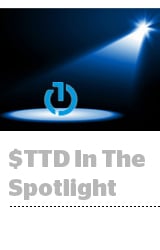 The Trade Desk recorded revenue of $112.3 million in Q2 2018, a 54% increase from the same period last year, according to the company’s earnings report released Thursday.
The Trade Desk recorded revenue of $112.3 million in Q2 2018, a 54% increase from the same period last year, according to the company’s earnings report released Thursday.
That growth rate is identical to 2017’s annual growth rate, and the company’s retention rate topped 95% for the 18th consecutive quarter.
On the company’s earnings call, CEO Jeff Green chalked up the sustained momentum to advertisers’ ongoing hunger for alternatives to large platform companies, as well as emerging channels.
“We continued to see marketers spend disproportionately more with The Trade Desk as they look beyond the few search and social sites that historically captured the most advertising dollars,” Green said. “Our strategy of being the best platform for media buying and not owning or arbitraging media is more valuable today than it ever was.”
The Trade Desk raised its annual revenue forecast to $456 million, up $23 million from its forecast last quarter and more than $50 million from the initial guidance it released in early 2018.
Europe’s General Data Protection Regulation (GDPR), which went into effect in May, caused minor stumbles out of the gate but hasn’t affected growth. The Trade Desk’s four European offices each reported record revenue this quarter.
The company also touted the launch of its new product suite in June. The campaign planning and management tools are “the biggest product launch in our company’s history,” Green said.
The new products, and increasingly The Trade Desk’s product development teams, are focused on delivering “consumer surpluses” for customers, he said.
The new AI-based targeting product called Koa, for instance, has helped some customers improve bid efficiency by upward of 20% by automatically accounting for changes in auction dynamics, such as first-price bidding or price floors set by supply-side platforms and publishers, Green said. Koa and the other products don’t raise the cost of using The Trade Desk’s platform, he said, but those kinds of improvements in efficiency and ROI help cover The Trade Desk’s roughly 20% fee.
The Trade Desk dedicated about 40% of its overall engineering resources to the new product suite last year. The company could have sold it as a premium add-on to recoup costs, but by keeping prices level while improving value and user experience, the company improves its retention rate and pitch to potential new customers.
“We are not maximizing profit for today. We’re doing the best thing for the growth of our business over the long term,” Green said.
The Trade Desk shares jumped more than 15% in after-hours trading.














